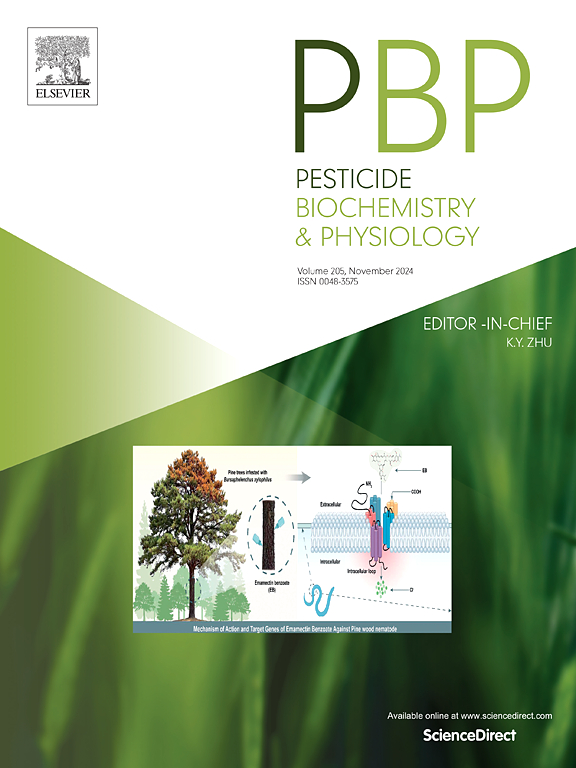Exposure to trans-anethole impairs reproduction and inhibits glutathione-S-transferase (GST) in engorged Rhipicephalus microplus female ticks (Acari: Ixodidae)
IF 4.2
1区 农林科学
Q2 BIOCHEMISTRY & MOLECULAR BIOLOGY
引用次数: 0
Abstract
Rhipicephalus microplus, the cattle tick, is a species of great importance to veterinary medicine and is responsible for massive economic losses in agriculture. In our study, engorged R. microplus females were exposed to the natural product trans-anethole in concentrations ranging from 1 to 50 μL/mL, a commercial pesticide (positive control), 5 % DMSO (solvent), and water control. We evaluated a series of endpoints related to survival, reproductive parameters, ovicidal activity, ovary histopathology, oxidative stress, and an in silico analysis (docking and molecular dynamics) of glutathione S-transferase (GST) inhibition. Exposure to 50 μL/mL trans-anethole caused mortality above 90 %, whereas in the positive control, this value was around 45 %. The mean lethal concentration (LC50) estimated for trans-anethole in engorged R. microplus seven days after the exposure was LC50 = 27.14 μL/mL. A concentration-dependent response was observed in the percentage of control (%C) in ticks treated with trans-anethole, reaching %C = 82.87 at 25 μL/mL. However, only the positive control presented an ovicidal effect against R. microplus. The most prevalent morphological alterations in the ovaries were basophilic granules in the cytoplasm, irregular oocyte shape, and fusion of yolk granules. The score of these alterations at 10 μL/mL trans-anethole was statistically equivalent to the positive control. Exposure to 10 μL/mL trans-anethole led to reduced GST activity. In silico analysis revealed inhibition of GST by trans-anethole with a MolDock score of −80.66. Collectively, our data showed that trans-anethole impairs the reproduction of R. microplus and is a promising bioactive compound for tick control.

暴露于反式甲醚会损害繁殖并抑制微小鼻头蜱雌性蜱的谷胱甘肽- s-转移酶(GST)。
牛蜱(Rhipicephalus microplus)是一种对兽医学非常重要的物种,对农业造成了巨大的经济损失。在本研究中,我们用浓度为1 ~ 50 μL/mL的天然产物反式茴香醇、商业杀虫剂(阳性对照)、5% DMSO(溶剂)和水作为对照。我们评估了一系列与存活、生殖参数、杀卵活性、卵巢组织病理学、氧化应激以及谷胱甘肽s -转移酶(GST)抑制的硅分析(对接和分子动力学)相关的终点。暴露于50 μL/mL反式茴香醚的死亡率在90%以上,而阳性对照的死亡率在45%左右。反式茴香醚暴露后7 d的平均致死浓度LC50为27.14 μL/mL。反式甲醚对蜱的对照率(%C)呈浓度依赖性,在25 μL/mL浓度下达到82.87 %C。而只有阳性对照对小弧菌有杀卵作用。卵巢最常见的形态学改变是细胞质嗜碱性颗粒,卵母细胞形状不规则,卵黄颗粒融合。在10 μL/mL反式茴香醚作用下,这些变化与阳性对照相当。暴露于10 μL/mL反式茴香油中导致GST活性降低。硅分析显示反式茴香醚对GST的抑制作用,MolDock评分为−80.66。综上所述,我们的数据表明,反式甲醚会损害微蜱的繁殖,是一种很有前景的生物活性化合物。
本文章由计算机程序翻译,如有差异,请以英文原文为准。
求助全文
约1分钟内获得全文
求助全文
来源期刊
CiteScore
7.00
自引率
8.50%
发文量
238
审稿时长
4.2 months
期刊介绍:
Pesticide Biochemistry and Physiology publishes original scientific articles pertaining to the mode of action of plant protection agents such as insecticides, fungicides, herbicides, and similar compounds, including nonlethal pest control agents, biosynthesis of pheromones, hormones, and plant resistance agents. Manuscripts may include a biochemical, physiological, or molecular study for an understanding of comparative toxicology or selective toxicity of both target and nontarget organisms. Particular interest will be given to studies on the molecular biology of pest control, toxicology, and pesticide resistance.
Research Areas Emphasized Include the Biochemistry and Physiology of:
• Comparative toxicity
• Mode of action
• Pathophysiology
• Plant growth regulators
• Resistance
• Other effects of pesticides on both parasites and hosts.

 求助内容:
求助内容: 应助结果提醒方式:
应助结果提醒方式:


